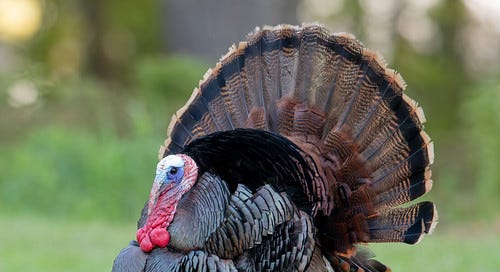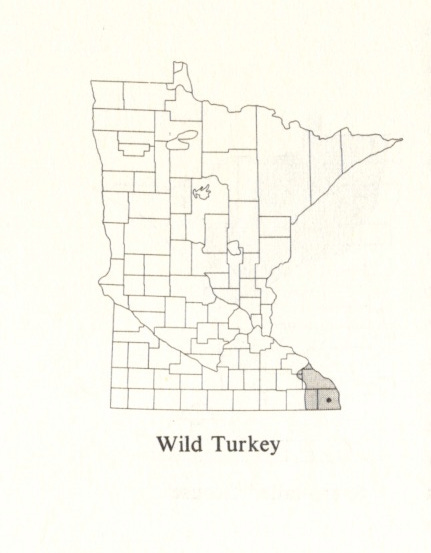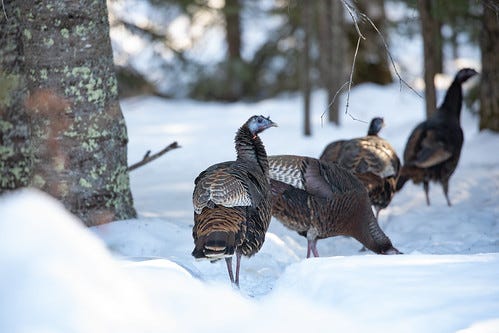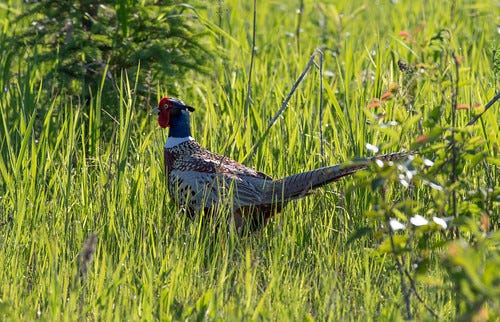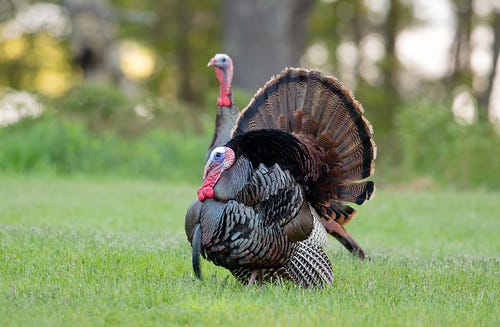(Listen to the radio version here.)
When I started producing “For the Birds” in 1986, Wild Turkeys were unheard of in Minnesota. Well, not exactly unheard of. The 1975 book Minnesota Birds: Where, When, and How Many by Green and Janssen listed the species as “hypothetical” based on T.S. Roberts’s 1932 Birds of Minnesota. After extensive research and scrutinizing accounts of early explorers, Roberts had concluded that the species probably never existed here historically.
But that 1975 book noted that the DNR (then the Minnesota Division of Game and Fish) had tried to introduce game-farm turkeys into the Whitewater Game Refuge in 1936 and between 1955 and 1959, to no avail. In 1964, 1965, and 1968, they tried again, this time releasing turkeys that had been trapped in the wild in other states. In their 1975 book, Green and Janssen noted that turkeys still remained there, and added that sportsmen’s groups had also released turkeys in several other southern counties and some of those releases appeared to be successful, too.
Bob Janssen updated that book in 1986 with his Birds in Minnesota. In just 11 years, the status of Wild Turkey had mushroomed from “Hypothetical” to “Permanent Resident.” Introductions were still taking place further north and west, and the species seemed firmly established only in Houston County and in and near the Whitewater Game Refuge.
Minnesota’s Breeding Bird Atlas, conducted from 2009–2013, showed how incredibly much the species has spread.

For the past two or three years, I’ve been seeing turkeys almost every time I visit the Sax-Zim Bog. I’ve seen them in Duluth only a couple of times, but I suspect this may be the next species I add to my yard list.
Wild Turkeys are splendid birds with far, far more than culinary value, but I’ve yet to see any introduction of any bird that didn’t harm the native species already here when white settlers first arrived. Most people are aware of the horrible impacts on cavity-nesting birds that House Sparrows and European Starlings have had; wildlife agencies focused on game species were never involved with those introductions.
Another introduction from another continent, the Ring-necked Pheasant, may be a lovely bird that keeps many hunters happy, but that introduction, supported and often led by departments of natural resources, had a serious impact on native Greater Prairie-Chickens and Northern Bobwhite.
Departments of natural resources have also worked hard to augment populations of some native American game species, making hunters happy at the expense of a lot of non-game species and sometimes even human beings. All kinds of problems, ecological and human-oriented, have cropped up with the extensive introductions of less migratory populations of Canada Geese. And several state DNRs have spent decades managing White-tailed Deer to “improve” their habitat at the expense of mature forests and grasslands; now deer overpopulation is a huge problem. White-tailed deer damage native vegetation and, surprisingly, eat eggs and nestlings of ground-nesting birds as well as causing sometimes fatal auto collisions. According to the Minnesota Office of Traffic Safety, between 2016 and 2020, there were 6,218 vehicle-deer collisions in Minnesota alone, leading to 124 serious injuries and 18 deaths.
In 2011, over a decade ago, there was a post on the 10,000 Birds blog about auto collisions with turkeys. As the population continues to increase in places where turkeys didn’t belong in the first place, so will this danger. And omnivorous turkeys are even more likely to feast on eggs and nestlings of ground nesting birds than deer do. They’re wonderful birds where they belong, but we really can have too much of a good thing.
Store-bought turkeys are the exact same species as Wild Turkeys, but virtually all descended from turkeys brought into captivity centuries ago that have been selectively bred to weigh much more and, especially, to have oversized pectoral muscles. Farm turkeys often cannot fly at all because those oversized breast muscles are so extremely heavy. Wild Turkeys, whether in states where they are native or introduced, can walk and fly.
In an episode of WKRP in Cincinnati, live turkeys were dropped from a helicopter in a promotional stunt. The final words of the episode made it clear that these turkeys were the farmed variety. “As God is my witness, I thought turkeys could fly.”


